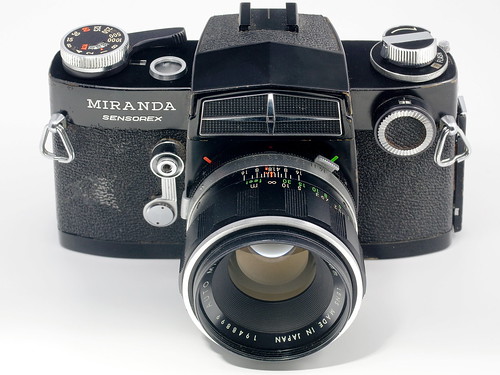Difference between revisions of "Miranda Sensorex"
Hanskerensky (talk | contribs) m (→Links: Refined Link URL) |
(→Links) |
||
| (7 intermediate revisions by 4 users not shown) | |||
| Line 20: | Line 20: | ||
|} | |} | ||
| − | [[Miranda]] launched the '''Sensorex''' in September 1966 | + | [[Miranda]] launched the '''Sensorex''' in September 1966.<REF> Date: p.29 of {{KKS}} no.64 (special issue on Miranda). </REF> It replaced the [[Miranda Automex III|Automex III]] and was Miranda's top of the line model. It has match-needle, full [[open-aperture metering]] and interchangeable viewfinders. It has a wheel on the front side to adjust to the metering system to the widest aperture of each attached lens. Early camera bodies had a removable back for a projected motor drive (which never materialized). The camera was discontinued in 1971 and replaced with the [[Miranda Sensorex II|Sensorex II]]. |
| − | The interchangeable viewfinder on the Sensorex is removed by sliding a small knob on the rear of the camera, next to the battery housing. Several viewfinders were made, and the camera is fully functional with the viewfinder removed, allowing a top down view straight onto the viewing screen<ref>This is not recommended, since | + | Meter cells are located behind unsilvered lines on the reflex mirror.<ref>For the [https://www.flickr.com/photos/camerawiki/52658407406/in/pool-camerawiki/ initial few years] the metering pattern was a central spot; but the manual linked below and [https://www.flickr.com/photos/simon-hawketts/15739625471/in/pool-camerawiki/ later examples] indicate a wider, bottom-weighted pattern ([https://www.flickr.com/photos/simon-hawketts/albums/72157646863205794 Sensorex example] from [https://www.flickr.com/photos/simon-hawketts/ Simon Hawketts]).</ref> The interchangeable viewfinder on the Sensorex is removed by sliding a small knob on the rear of the camera, next to the battery housing. Several viewfinders were made, and the camera is fully functional with the viewfinder removed, allowing a top down view straight onto the viewing screen<ref>This is not recommended, since stray light entering via the view-screen can result in under-exposure; the use of made-for-purpose Miranda hooded waist-level finders is recommended.</ref>. |
| Line 29: | Line 29: | ||
==Links== | ==Links== | ||
| − | * [http://www.mirandacamera.com/_modelinfo/_sensorex/sensorex.htm Miranda Sensorex] by [http://www.mirandacamera.com/ Miranda Historical Society] | + | * [https://web.archive.org/web/20200218051953/http://www.mirandacamera.com/_modelinfo/_sensorex/sensorex.htm Miranda Sensorex] by [https://web.archive.org/web/20200918225642/http://www.mirandacamera.com/ Miranda Historical Society] (archived) |
| − | * [ | + | * [https://www.butkus.org/chinon/miranda/miranda_sensorex/senorex.htm Miranda Sensorex (English / multiple language) PDF manual] at [https://www.butkus.org/chinon/index.html OrphanCameras.com] |
| − | * [ | + | * [https://www.flickr.com/photos/camerawiki/52634351122/in/pool-camerawiki/ November, 1966, ''Popular Photography'' advertisement] soon after launch (Vol, 59, No. 5; pages 22-23) |
| + | * [https://youtu.be/P3nLQ9iedk8 Miranda Sensorex video presentation] by YouTuber [https://www.youtube.com/@MrKayFisher Kay's Cameras] | ||
In German | In German | ||
*[http://www.artaphot.ch/historische-kameras/362-miranda-sensorex Miranda Sensorex] on [http://www.artaphot.ch/historische-kameras/361-mamiya-500-dtl artaphot] | *[http://www.artaphot.ch/historische-kameras/362-miranda-sensorex Miranda Sensorex] on [http://www.artaphot.ch/historische-kameras/361-mamiya-500-dtl artaphot] | ||
| + | * [https://www.butkus.org/chinon/miranda/miranda_sensorex/senorex.htm Miranda Sensorex Bedienungsanleitung PDF] at [https://www.butkus.org/chinon/index.html OrphanCameras.com] | ||
| + | |||
| + | In French | ||
| + | * [https://www.butkus.org/chinon/miranda/miranda_sensorex/senorex.htm Miranda Sensorex Mode d'emploi PDF] at [https://www.butkus.org/chinon/index.html OrphanCameras.com] | ||
[[Category:Japanese 35mm SLR]] | [[Category:Japanese 35mm SLR]] | ||
[[Category:Miranda|Sensorex]] | [[Category:Miranda|Sensorex]] | ||
[[Category: M]] | [[Category: M]] | ||
| + | [[Category:S|Sensorex Miranda]] | ||
Latest revision as of 15:22, 4 April 2024
|
|
Miranda launched the Sensorex in September 1966.[1] It replaced the Automex III and was Miranda's top of the line model. It has match-needle, full open-aperture metering and interchangeable viewfinders. It has a wheel on the front side to adjust to the metering system to the widest aperture of each attached lens. Early camera bodies had a removable back for a projected motor drive (which never materialized). The camera was discontinued in 1971 and replaced with the Sensorex II.
Meter cells are located behind unsilvered lines on the reflex mirror.[2] The interchangeable viewfinder on the Sensorex is removed by sliding a small knob on the rear of the camera, next to the battery housing. Several viewfinders were made, and the camera is fully functional with the viewfinder removed, allowing a top down view straight onto the viewing screen[3].
Notes
- ↑ Date: p.29 of Kurashikku Kamera Senka no.64 (special issue on Miranda).
- ↑ For the initial few years the metering pattern was a central spot; but the manual linked below and later examples indicate a wider, bottom-weighted pattern (Sensorex example from Simon Hawketts).
- ↑ This is not recommended, since stray light entering via the view-screen can result in under-exposure; the use of made-for-purpose Miranda hooded waist-level finders is recommended.
Links
- Miranda Sensorex by Miranda Historical Society (archived)
- Miranda Sensorex (English / multiple language) PDF manual at OrphanCameras.com
- November, 1966, Popular Photography advertisement soon after launch (Vol, 59, No. 5; pages 22-23)
- Miranda Sensorex video presentation by YouTuber Kay's Cameras
In German
In French

